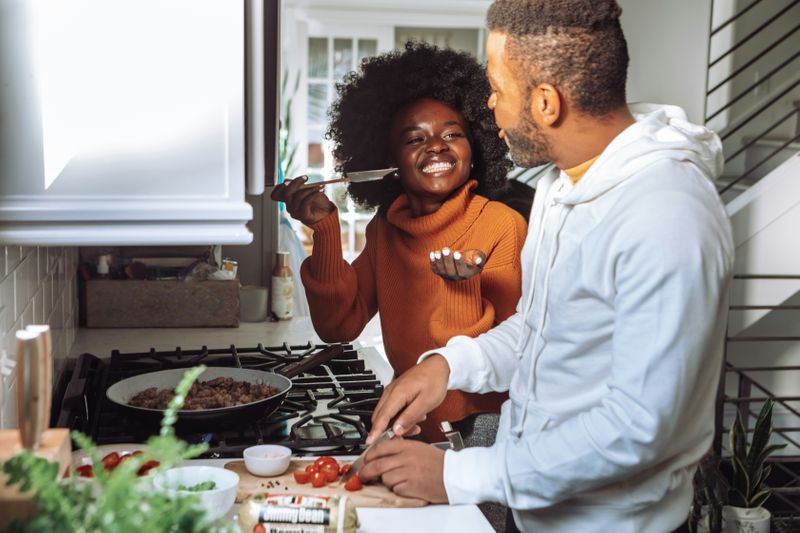 Photo by Jeremy Bishop on Unsplash
Photo by Jeremy Bishop on UnsplashThe great philosopher Aristotle once said:
Love is composed of a single soul inhabiting two bodies.
It's a beautiful way to think about love. After being in a happy, healthy relationship for 6 years, I can honestly say I truly feel "as one" with my partner.
But what does it take to make a relationship like that last? The secret is emotional closeness.
What is Emotional Closeness?
 Photo by Karsten Winegeart on Unsplash
Photo by Karsten Winegeart on UnsplashEmotional closeness (also referred to as "emotional intimacy") is a strong bond where you feel safe, secure, and vulnerable around your partner. It's essential to creating healthy, long-lasting relationships.
It's more than going on dates and saying "I love you" — it's about building a connection through trust, understanding, and open communication.
Developing emotional closeness with your partner can be achieved in 5 meaningful ways.
1. Talk to Each Other
 Photo by Aarón Blanco Tejedor on Unsplash
Photo by Aarón Blanco Tejedor on UnsplashOne way to develop emotional closeness is to simply spend more time talking to each other.
Share Stories
These stories can be anything. Memories, funny moments, personal experiences —anything that reflects your personality and life journey. Stories can open up discussions and create a deeper understanding of your beliefs and backgrounds.
Ask Questions
Learn how your partner thinks, feels, or reacts to specific situations. Some questions include:
"What are your current goals or dreams?"
"When you were a child, what did you want to be?"
"What's your favorite memory of us?"
"What's a hobby you've always wanted to try?"
"If you could do one thing for free for a year, what would you do?"
2. Participate in Activities Together
 Photo by Jimmy Dean on Unsplash
Photo by Jimmy Dean on UnsplashWhether it's participating in your partner's hobbies or exploring something entirely new together, shared activities create emotional closeness by creating positive memories.
You could try activities such as:
Cooking a meal together
Going for a nature walk together
Taking a dance class together
Reading a book together
Playing co-op video games
3. Be Alone Together

Sometimes, the most meaningful connections happen when you and your partner can simply exist in the same space, each doing your own thing.
This practice of engaging in individual activities within the same room is called "parallel play". For example, one person might read while the other plays a video game.
The most compatible partners are not those who can constantly entertain each other, but who can simply enjoy each other's company. It's a quiet, comforting activity that can nurture emotional closeness.
4. Show Physical and Verbal Affection
 Photo by Ruthson Zimmerman on Unsplash
Photo by Ruthson Zimmerman on UnsplashShowing your partner physical and verbal affection helps them feel valued, especially nonsexual displays of affection. Simple gestures like holding hands, hugging, or thoughtful compliments show that you care.
Your partner is more than what they physically bring to the relationship. To develop emotional closeness, it's important to appreciate your partner for who they are.
You might say things such as:
"I love you so much."
"You mean the world to me."
"I appreciate everything you do for me."
"You make me so happy."
"I'm proud of you."
5. Respect Each Other's Boundaries

Remember, a healthy relationship isn't about being together all the time — it's about trusting your partner to enjoy their own experience, interests, and independence. Respecting your partner's boundaries lays the foundation of a healthy relationship.
How do I know if my boundaries are healthy?
Some examples of healthy boundaries include:
Respecting alone time
Maintaining your own social circles as individuals
Respecting digital privacy and personal belongings
Acknowledging each others' interests and hobbies
Honoring physical comfort levels (hugging, kissing, etc.)
Validating emotional needs and limits
When both partners feel safe and respected, emotional closeness grows.
Emotional Closeness: How to Know It's Working

Say you do all the activities listed earlier. How do you know that it's working? Consider the following:
Are you unapologetically yourself around them?
Do you feel comfortable being vulnerable and sharing your insecurities with them?
Are you able to laugh together and find joy in the little moments?
Can you rely on them for emotional support during difficult times?
Are you celebrating their accomplishments and successes as much as your own?
If you answered yes to all, you and your partner have developed emotional closeness.
Quiz
You and your partner have been busy and haven't spent much quality time together. What's the best way to rebuild emotional closeness?
Take Action

Building emotional closeness and a happy relationship takes time and effort. If you're making time to talk, plan dates, and show care for each other's needs, you're on the right track.
Your feedback matters to us.
This Byte helped me better understand the topic.
